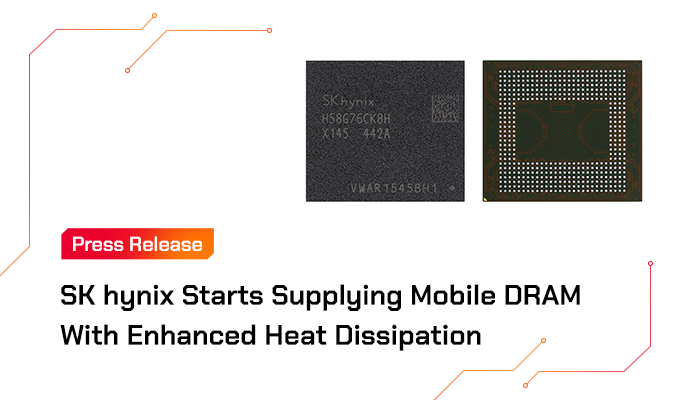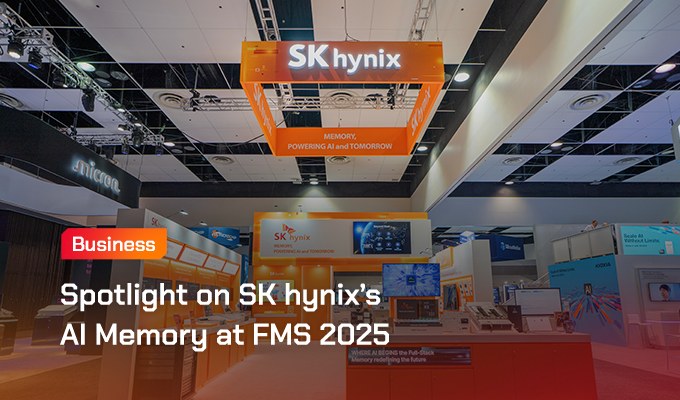
What fuels progress in the rapidly changing semiconductor world? While invention is the driver behind many advancements, reimagining the use of existing technologies for new applications can also overcome barriers to progress. This latter approach enabled SK hynix to make huge strides in the mobile DRAM field.
While the semiconductor industry struggled to continue mobile DRAM scaling1, SK hynix made a significant breakthrough with the world’s first application of High-K Metal Gate (HKMG) to mobile DRAM. Through this innovative use of the long-established HKMG process, the company was able to develop next-generation LPDDR2 products which set new standards in performance.
1Scaling: The reduction in size of semiconductors to produce better device performance, power efficiency, and cost.
2Low Power Double Data Rate (LPDDR): Low-power DRAM products for mobile devices, including smartphones and tablets, aimed at minimizing power consumption and featuring low voltage operation.
This Rulebreakers’ Revolutions episode focuses on SK hynix’s groundbreaking application of HKMG and the challenges the company overcame to integrate this process to mobile DRAM.

The Mission: Tackle Power Loss Issues to Continue Mobile DRAM Scaling
The growth of on-device AI and other applications is placing ever-increasing performance demands on mobile devices. In turn, mobile DRAM must continue scaling down and provide faster processing speeds to support these applications while maintaining low-power consumption. However, there are issues with the continued miniaturization of mobile DRAM transistors through traditional processes.
A DRAM typically includes cell transistors which store data and peripheral (peri.) transistors responsible for data input and output. To improve DRAM performance, it is necessary to scale down transistors which brings the source3 and drain4 closer together and increases the current. However, to reduce power consumption, the operating voltage to the gate5 must be decreased. Consequently, the gate insulating film must be thinned to improve transistor performance at a lower voltage.
In standard DRAM products including mobile DRAMs, this insulating film is generally made from silicon oxynitride (SiON) which encounters reliability issues when reduced in thickness. Moreover, the thinning of SiON insulators increases the amount of leakage current6, leading to a loss of power. This is a significant issue for battery-powered mobile devices in which low-power consumption is critical to extend the usage time on a single charge.
3Source: The terminal through which the majority charge carriers enter the transistor.
4Drain: The terminal through which the majority charge carriers exit from the transistor.
5Gate: A component in a transistor that controls the flow of electric current by acting as an on-off switch.
6Leakage current: Unwanted flow of electrical current that occurs when the transistor is in the off state.

SiON insulators in conventional transistors are a barrier to DRAM scaling
To tackle this power consumption issue and ultimately ensure the continued scaling of mobile DRAM without compromising performance, SK hynix once again broke the rules of convention and turned to a long-standing technology—HKMG.
The Future Lies in The Past: World-First HKMG Application & Integration Challenges
HKMG was commercialized over a decade ago, first used in logic semiconductors and then applied to high-performance DRAM memory. Although HKMG was an established technology, SK hynix was the first company to see it as a solution to the scaling limitations of mobile DRAM while others continued with traditional processes. This pioneering application of HKMG and optimization of the process revolutionized the mobile DRAM sector, paving the way for ultra-low-power and ultra-high-speed solutions.

The groundbreaking application of HKMG enabled mobile DRAM to continue scaling
So what is HKMG and how does it solve the issues of the traditional SiON process? The HKMG process involves replacing the traditional SiON insulator in transistors with a thin High-K film which prevents leakage currents and improves reliability. Offering high levels of permittivity7, High-K film provides equivalent electrical characteristics as a film five times thicker. This thinner film enables continuous transistor scaling, resulting in faster speeds and lower power characteristics compared to SiON-based transistors.
7Permittivity: Degree of how many electrons can be stored inside a gate.

The HKMG process tackled the power and performance issues associated with SiON insulators in conventional transistors
As the whole HKMG process had never been applied to mobile DRAM before, SK hynix had to optimize the process and overcome challenges to ensure its smooth application. One of the most significant risks the company recognized was the potential for defects to arise from the application of HKMG to mobile DRAM. In particular, when applying the HKMG process to an LPDDR product for the first time, various stability issues arising from the use of new materials could cause chip defects. To combat this, SK hynix conducted preliminary evaluations through pilot products. Through these various evaluations and tests along with leveraging cross-company expertise, SK hynix was able to maximize transistor performance and ultimately secure the integrated process solution for mobile DRAM.
Unlocking New LPDDR Solutions

The first-ever mobile DRAM products made with the HKMG process offered huge leaps in power and speed
The successful integration of the HKMG process with mobile DRAM paved the way for SK hynix to develop new ultra-low-power and rapid LPDDR solutions. In November 2022, the company released the world’s first ever mobile DRAM with the integrated HKMG process, Low Power Double Data Rate 5X (LPDDR5X). The product offered ultra-low operating power of 1.01–1.12V and an operating speed of 8.5 Gbps. LPDDR5X is 33% faster and uses 21% less power compared to the previous generation, ensuring it meets both sustainability goals to lower carbon emissions and technological targets.
Just two months later, SK hynix once again set new standards in mobile DRAM with the introduction of Low Power Double Data Rate Turbo (LPDDR5T). While LPDDR5T operates at the same low voltage as LPDDR5X and provides a 21% reduction in power consumption from LPDDR5, it also offers significant leaps in speed from its predecessor. At the time of its release, LPDDR5T was the world’s fastest mobile DRAM, boasting an impressive operating speed of 9.6 Gbps—13% faster than LPDDR5X and 50% quicker than LPDDR5. Such speeds were only thought of as possible with the next-generation LPDDR6, but the company was able to reach new heights ahead of schedule thanks largely to the application of HKMG.
Rulebreaker Interview: Jongchan Choi, Product Solution Process Integration

To learn more about the “rulebreaking” approach which led to the application of HKMG to mobile DRAM, the SK hynix newsroom interviewed Team Leader Jongchan Choi of Product Solution Process Integration. Choi, who helped develop the process solution when HKMG was first applied to LPDDR products, discusses the future direction of HKMG and its potential future applications beyond mobile DRAM.
Can you tell us more about why HKMG was applied to mobile DRAM?
“In the AI era, the market demands mobile DRAM that not only offers low power but also high-speed characteristics. Generally, power and speed have a trade-off relationship, making it very difficult to improve both simultaneously. However, HKMG technology is a solution that can overcome this challenge.
“With the goal of regaining leadership in the mobile DRAM market and achieving the highest possible speed, we decided to apply HKMG technology to mobile DRAM through a thorough technological preparation process. I believe it provides a foundation for expanding into various DRAM applications that meet customer demands by significantly improving power leakage and speed.”
How do you foresee the evolution of HKMG and HKMG-based solutions?
“SK hynix continues to improve devices and processes to maximize the competitiveness of the first-generation HKMG Technology Platform. Additionally, as customer expectations for high speed and low power continue to rise, we must continue to develop technology which maximizes DRAM performance. In light of this, we are developing the next-generation HKMG Technology Platform.
“In terms of specific products, the LPDDR5 lineup has a growing array of applications including not only mobile devices but also data centers that require vast amounts of power. These ultra-low-power LPDDR solutions cut energy consumption, helping to reduce carbon emissions and thereby maximizing the ESG values that SK hynix pursues.”

What challenges did you face during the application of HKMG and how did SK hynix’s “rulebreaking” spirit help you overcome these obstacles?
“HKMG is a particularly challenging technology to implement and required thorough preparation to ensure its successful application. We determined that the existing technology pre-verification process was limited, so we significantly enhanced the HKMG verification procedures and executed a schedule and goals that were ‘challenging but achievable’ for us. This shows how we continually look to push the limits to reach new heights.
“Collaboration was also key to the success of the project. After the decision was made to deploy HKMG to overcome the limits of high speed and low power in mobile DRAM, the entire company organized teams and provided resources for technology development.
“I believe that by communicating the importance and value of HKMG, recognizing contributions to successful technology development, and rewarding achievements, we help motivate members to stay focused and not lose sight of our long-term development goals.”
Read more articles from the Rulebreakers’ Revolutions series









